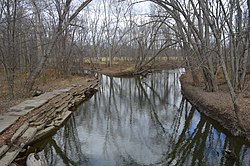St. Joseph River (Maumee River tributary)
The St. Joseph River (Miami-Illinois: Kociihsasiipi)[1] is an 86.1-mile-long (138.6 km)[2] tributary of the Maumee River in northwestern Ohio and northeastern Indiana in the United States, with headwater tributaries rising in southern Michigan. It drains a primarily rural farming region in the watershed of Lake Erie.
| St. Joseph River Little St. Joseph River, Bean Creek, Kochisahsepe | |
|---|---|
 Map of the Maumee River watershed showing the St. Joseph River. | |
| Location | |
| Country | United States |
| Physical characteristics | |
| Source | |
| • location | Hillsdale County, Michigan |
| • coordinates | 41°38′53″N 84°33′56″W / 41.6480556°N 84.5655556°W |
| • elevation | 856 ft (261 m) |
| Mouth | |
• location | Maumee River, Ft. Wayne, Indiana |
• coordinates | 41°05′00″N 85°07′56″W / 41.0833333°N 85.1322222°W |
• elevation | 751 ft (229 m) |
| Length | 100 mi (160 km) |
| Basin features | |
| Tributaries | |
| • left | West Branch St. Joseph River |
| • right | East Branch St. Joseph River |
| GNIS ID | 2678706 |


The St. Joseph River of Lake Michigan is an entirely separate river that rises in western Michigan, dips into Indiana, and flows west into Lake Michigan.
Origin
At the end of the Wisconsin glaciation, the glacier's Erie Lobe retreated toward the northeast, leaving large debris deposits called moraines. The St. Joseph formed as a meltwater channel between the north limbs of two of these moraines, the Wabash Moraine on the west and the Fort Wayne Moraine on the east. At that time it joined the St. Marys River to drain into the Wabash River. Later, the shrinkage of Glacial Lake Maumee, the ancestor of modern Lake Erie, brought about the opening of the modern Maumee River, which captured the flow of the St. Joseph and the St. Marys, causing the St. Marys to reverse its course to meet the flow of the St. Joseph almost head-on.
The St. Joseph today
The St. Joseph River forms in northern Williams County, Ohio, at the confluence of the East and West branches at 41°38′54″N 84°33′55″W / 41.64833°N 84.56528°W.[3][4][5] Both branches rise in southern Hillsdale County, Michigan. The headwaters of the East Branch are within 3 miles (4.8 km) of those of the St. Joseph River of Lake Michigan. Both branches initially flow southeast, then turn to the southwest to flow across the northwestern corner of Ohio past Montpelier. The St. Joseph enters De Kalb County in northeastern Indiana, flowing southwest past Saint Joe and into the city of Fort Wayne, where it meets the St. Marys River to form the Maumee River at 41°04′58″N 85°07′56″W / 41.08278°N 85.13222°W.[6] The US Army Corps of Engineers built a flood control project in Fort Wayne that includes a floodwall and upper roadway along the St. Joseph River. (See photo)
Tributaries
From the mouth:
- (left) Becketts Run[7]
- (right) Tiernan Ditch
- (left) Ely Run[8]
- (left) Cedar Creek[9]
- Cedarville Reservoir[10]
- (left) Swartz-Carnahan Ditch[14]
- Dunton Lake[15]
- (right) Boger Ditch[16]
- (left) Metcalf Ditch[17]
- (right) Walker Ditch[18]
- (left) Dilley Ditch[19]
- (left) Wade Ditch[20]
- (left) Bear Creek[21]
- (right) Nancy Davis Ditch
- (left) Sol Shank Ditch[26]
- (right) Melissa Ditch[31]
- (left) Buck Creek[32]
- (left) Christoffel Ditch[37]
- (right) Willow Run[38]
- (right) Amaden Ditch[39]
- (right) Greens Ditch[40]
- (right) Foulks Ditch[41]
- (left) Peter Grube Ditch[42]
- (left) Big Run[43]
- (left) Russell Run[54]
- (left) Fish Creek[55]
- (left) Bluff Run[69]
- (left) Bear Creek[70]
- (left) Tamarack Ditch[71]
- (left) Eagle Creek[72]
- (right) North Branch Eagle Creek[73]
- (left) Nettle Creek[74]
- (right) East Branch St. Joseph River (rises in southwest Adams Township, Hillsdale County, Michigan at 41°54′17″N 84°33′52″W / 41.90472°N 84.56444°W[4])
- (left) West Branch St. Joseph River (rises just south of the intersection of Carpenter Rd. and W. Territorial Rd. in southern Cambria Township, Hillsdale County, Michigan at 41°38′53″N 84°41′24″W / 41.64806°N 84.69000°W[5])
- Lake Seneca[94]
- (left) outflow from Lake La Su An[95]
- (right) East Fork West Branch St. Joseph River (rises in northwest Cambria Township, Hillsdale County, Michigan at 41°51′53″N 84°40′34″W / 41.86472°N 84.67611°W[96])
- (left) West Fork West Branch St. Joseph River (rises from the outflow of Rebeck Lake in northwest Camden Township, Hillsdale County, Michigan at 41°48′22″N 84°48′22″W / 41.80611°N 84.80611°W[108])
- Lake Seneca[94]
Drainage basin
The St. Joseph River and tributaries drain all or portions of the following:
- Allen County, Indiana
- DeKalb County, Indiana
- Noble County, Indiana
- Steuben County, Indiana
- Defiance County, Ohio

See also
- List of Indiana rivers
- List of Michigan rivers
- List of rivers of Ohio
- USS St. Joseph's River, a World War II-era US Navy vessel named after this river.
References
Further reading
External links
